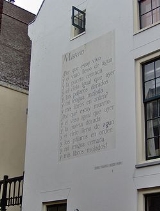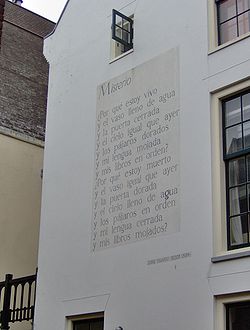
Jorge Eielson
Encyclopedia

Peru
Peru , officially the Republic of Peru , is a country in western South America. It is bordered on the north by Ecuador and Colombia, on the east by Brazil, on the southeast by Bolivia, on the south by Chile, and on the west by the Pacific Ocean....
vian artist
Artist
An artist is a person engaged in one or more of any of a broad spectrum of activities related to creating art, practicing the arts and/or demonstrating an art. The common usage in both everyday speech and academic discourse is a practitioner in the visual arts only...
and writer
Writer
A writer is a person who produces literature, such as novels, short stories, plays, screenplays, poetry, or other literary art. Skilled writers are able to use language to portray ideas and images....
. As an artist he is known for his quipu
Quipu
Quipus or khipus were recording devices used in the Inca Empire and its predecessor societies in the Andean region. A quipu usually consisted of colored, spun, and plied thread or strings from llama or alpaca hair. It could also be made of cotton cords...
s, a reinterpretation of an ancient Andean device, they are considered precursors of conceptual art
Conceptual art
Conceptual art is art in which the concept or idea involved in the work take precedence over traditional aesthetic and material concerns. Many of the works, sometimes called installations, of the artist Sol LeWitt may be constructed by anyone simply by following a set of written instructions...
.
Eielson was born in Lima
Lima
Lima is the capital and the largest city of Peru. It is located in the valleys of the Chillón, Rímac and Lurín rivers, in the central part of the country, on a desert coast overlooking the Pacific Ocean. Together with the seaport of Callao, it forms a contiguous urban area known as the Lima...
on April 13, 1924. His father died when he was seven years old so he was raised by his mother. At a young age he developed artistic tendencies: he played the piano, drew copiously and recited poetry. Eielson switched schools several times until at the end of his secondary education
Secondary education
Secondary education is the stage of education following primary education. Secondary education includes the final stage of compulsory education and in many countries it is entirely compulsory. The next stage of education is usually college or university...
he met the anthropologist and writer José María Arguedas
José María Arguedas
José María Arguedas Altamirano was a Peruvian novelist, poet, and anthropologist who wrote mainly in Spanish, although some of his poetry is in Quechua...
who introduced him to the artistic and literary circles of Lima as well as to the knowledge of the ancient civilizations of Peru. Eielson started studies at the National University of San Marcos
National University of San Marcos
The National University of San Marcos is the most important and respected higher-education institution in Peru. Its main campus, the University City, is located in Lima...
in 1941. He won the National Poetry Award three years later and the National Drama Award in 1948, when he also held a successful art exhibition
Art exhibition
Art exhibitions are traditionally the space in which art objects meet an audience. The exhibit is universally understood to be for some temporary period unless, as is rarely true, it is stated to be a "permanent exhibition". In American English, they may be called "exhibit", "exposition" or...
at the Lima Gallery .
In the same year, he traveled to Paris under a French government scholarship, in that city he exhibited at the Colette Allendy gallery before traveling to Switzerland thanks to a UNESCO scholarship. In 1951, he travels to Italy for a summer vacation and decides to settle permanently in Rome. During this period he wrote the collection of poems Habitación en Roma and two novels: El cuerpo de Giulia-No and Primera muerte de María. In the late 1950s, he abandoned avant-garde
Avant-garde
Avant-garde means "advance guard" or "vanguard". The adjective form is used in English to refer to people or works that are experimental or innovative, particularly with respect to art, culture, and politics....
and resorts to using materials such as earth, sand and clay to sculpt in the canvas surface; at first he uses this technique to depict landscapes but gradually moves towards human figures represented through clothing of various kinds. In 1963 he started his first quipu
Quipu
Quipus or khipus were recording devices used in the Inca Empire and its predecessor societies in the Andean region. A quipu usually consisted of colored, spun, and plied thread or strings from llama or alpaca hair. It could also be made of cotton cords...
, reinventing this ancient Andean device with fabrics of brilliant colors, knotted and tied on canvas. Eielson's quipus were exhibited in the 1964 Venice Biennale
Venice Biennale
The Venice Biennale is a major contemporary art exhibition that takes place once every two years in Venice, Italy. The Venice Film Festival is part of it. So too is the Venice Biennale of Architecture, which is held in even years...
to wide acclaim. In the mid 1970s, he traveled to Peru where he devoted himself to the study of pre-Columbian art; during this period, the Instituto Nacional de Cultura (National Institute of Culture) published most of his poetry under the title Poesía escrita. He received a Guggenheim Fellowship
Guggenheim Fellowship
Guggenheim Fellowships are American grants that have been awarded annually since 1925 by the John Simon Guggenheim Memorial Foundation to those "who have demonstrated exceptional capacity for productive scholarship or exceptional creative ability in the arts." Each year, the foundation makes...
in 1978 for a lecture in New York.
Written works:
Poetry
- Reinos (1944)
- Canción y muerte de Rolando (1944 and 1959)
- Mutatis mutandis (1967)
- Poesía escrita (1976)
- Canto visible (1977)
- Noche oscura del cuerpo (1989)
Novel
- El cuerpo de Giulia-No (1971)

